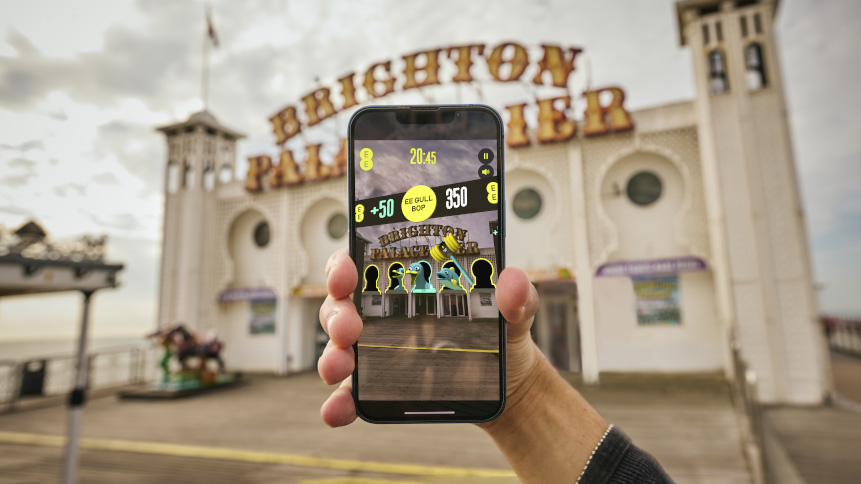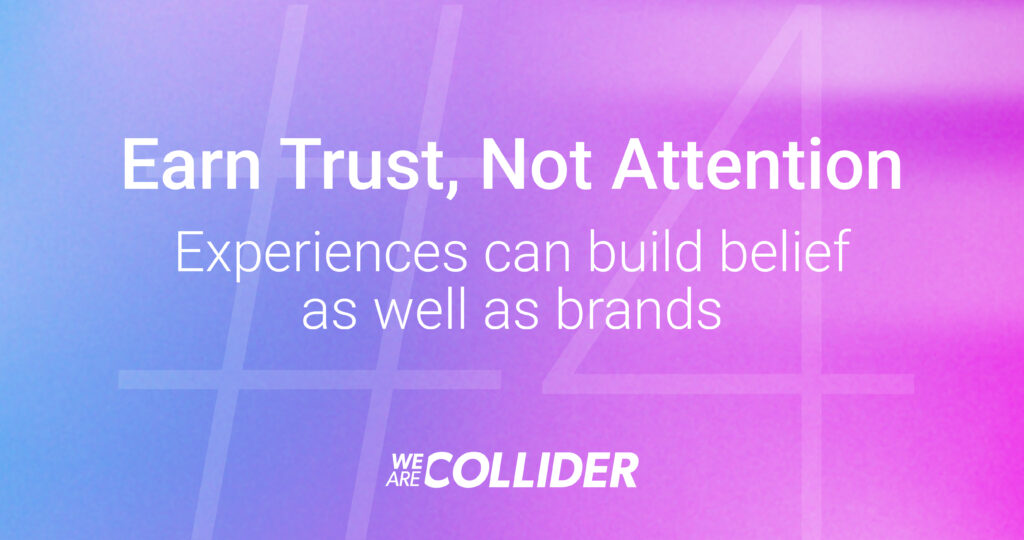If you’ve been following along with our blog series, you’ll be familiar with the pioneering work coming out of Arq, our dedicated R&D lab. One of its most compelling recent innovations is its ‘STAGE’ model, a behaviourally informed framework built on a foundation of academic research, expert insights, and a nationwide survey of 550 UK adults. At its heart are five science-backed levers designed to help brands and marketers unlock more powerful, effective immersive brand activations.
- Self: empower personal identity, ownership and creativity
- Transformative: enable growth, meaning, inspiration, or real-world impact
- Accessible: ensure ease of use, inclusivity, trust and comfort
- Gamified: use play, competition, interactivity and social bonding
- Extraordinary: deliver awe, surprise and impossible experiences
To date, we’ve published three blogs unpacking ‘Self,’ ‘Transformative,’ and ‘Accessible,’ the first three levers that show how immersive brand experiences connect with people on a personal, emotional and inclusive level. Each of the different focus areas explores how immersive media can move from novelty to necessity, helping people to craft brand experiences that feel human, not just high-tech.
Today, it’s time to introduce the fourth lever: Gamified.
What Is ‘Gamified’?
Gamified is where things get playful. This lever is all about play, participation, and progression, a place where brand experiences invite people not just to engage, but to feel challenged, rewarded, and socially connected. At their core, gamified experiences are immersive environments that use game mechanics, social interaction and competition to drive engagement. This is all about transforming passive moments into active ones. The concept takes the foundational elements of play (for example, exploration, competition, progress and reward) then directly applies them to brand experiences, creating a cycle of activity that feels emotionally rewarding and behaviourally compelling.
In Arq’s STAGE research, participants described gamified experiences using phrases like “there was an element of competition,” “I bonded with people,” “it had game mechanics,” and “it involved social interaction or collaboration.” This reflects how well-crafted gamified environments can encourage connection, engagement and a sense of progress. This is because gamification is not just about points or leaderboards: it covers everything from team-based challenges and problem-solving to digital collectables and socially shareable milestones.
People don’t want to be passive observers; they want to participate. The gamification lever can give them an active role in the experience, which in turn makes it more memorable, meaningful and worth sharing.
The psychological science of ‘Gamified’
Viewed through a behavioural science lens, gamification brings together multiple psychological principles into a single interactive package. For example, it:
- Fulfils core human needs. Games offer a sense of progress (i.e. we’re getting somewhere), mastery (i.e. we’re getting better) and connection (we’re not doing it alone). These can be deeply motivating, and deeply marketable, forces.
- Creates habit loops. Through systems of rewards, feedback and pacing, gamified experiences encourage repeated behaviour. This is the phenomenon first identified by psychologist B.F. Skinner called ‘operant conditioning’ in action (describing a way of learning through rewards and consequences), and also why so many people return again and again to an app, a challenge or a platform.
- Supports memory and attention. Behavioural research tells us that people remember content better when they have to interact with it. This is called the ‘Generation Effect,’ which is the difference between being told something and figuring out something for yourself.
- Enhances emotional engagement. When people are involved in a challenge or enjoying a game, they are also more emotionally tuned in. That’s the ideal state for brands looking to build connection and influence behaviour.
In short, gamification works because it invites people to play an active role. It turns audiences into participants, and participants into loyalists.
How brands are pulling the ‘gamified’ lever IRL
Fusing sport, tech and fan culture, EE recently partnered with Nexus Studios to launch a nationwide augmented reality event called EE Game Day. Major UK cities were transformed into interactive playgrounds, where fans could access football-themed mini-games using QR codes placed in real-world locations. The activation harnessed multiple behavioural triggers: movement, curiosity, competition and reward. It wasn’t just about looking at an ad; it was about doing something in real time, which in turn created urgency, offered clear goals and made people feel part of a shared event. That sense of play, progress and participation is exactly what makes gamification such a powerful tool for brand engagement.
Lacoste is another brand making great use of gamified experiences to strengthen loyalty amongst their consumers and elevate its digital retail presence. Working with Emperia, the brand launched a virtual store showcasing its summer collection, accessible via its website. Loyalty members from Le Club Lacoste and UNDW3 were able to unlock exclusive rooms, physical-meets-digital twin items, and a crocodile-themed scavenger hunt that led to rewards and a private shopping space.
And finally, to launch its Gen Z fashion line, Walmart built a virtual world inside Roblox where players could explore new fashion drops, complete challenges, and earn rewards. The activation used core game mechanics such as questing, achievement, personalisation and social sharing to drive sustained interaction, while also tapping into identity and self-expression, demonstrating how Gamified can intersect with the Self lever to create even deeper resonance. The result was a branded space that didn’t just promote products but encouraged users to play with them.
In all three examples, gamification wasn’t a bolt-on but a core design principle. These experiences gave people reasons to stay longer, return frequently, and share what they were doing, exactly what brands should be aiming for in the immersive space.
Playful is powerful: why ‘gamified’ matters now
Remember, gamification isn’t about turning everything into a game: it’s about using playful design to make immersive brand experiences more engaging, memorable and rewarding.
When experiences are gamified, they become ‘sticky.’ These kinds of events are fun, social, but most of all satisfying: keeping people interested by adding challenges, collaboration and rewards. Even better, when paired with other STAGE levers like Self or Extraordinary, the impact of gamified experiences grows even stronger, creating moments that people genuinely want to be part of.
Stay tuned for the fifth and final lever, which is all about awe, surprise and the impossible combining to deliver unforgettably ‘Extraordinary’ experiences.
Want to unlock the ‘Gamified’ lever in your next immersive brand experience? Email Charlotte to explore how Arq’s STAGE model can sharpen your next activation: charlotte.bunyan@arq-lab.com
Image source: Nexus Studios & EE





